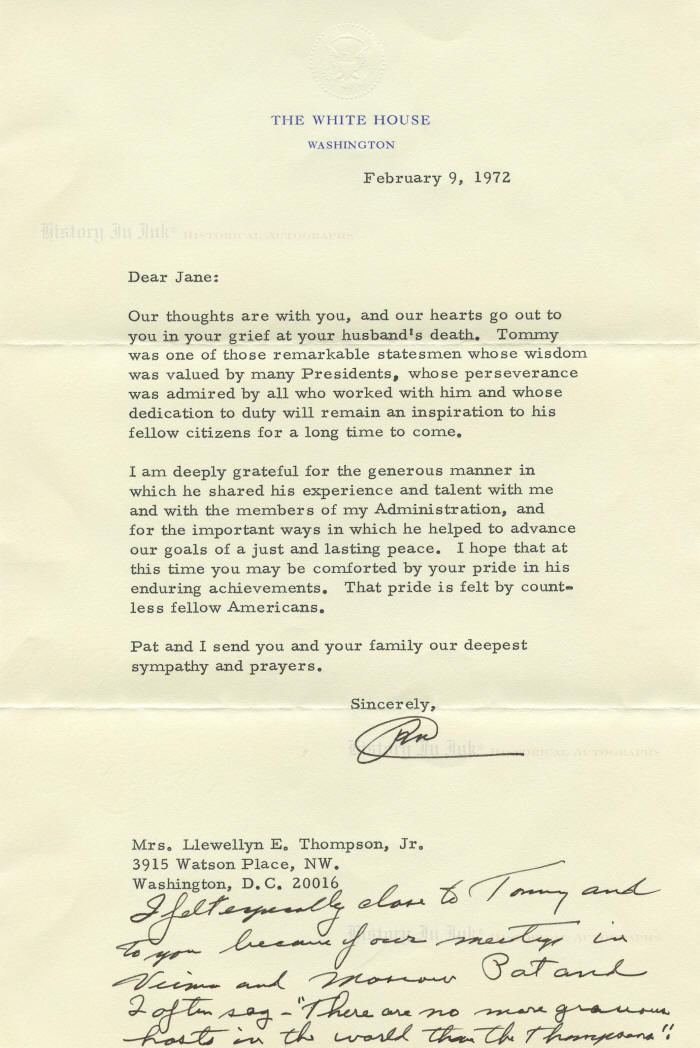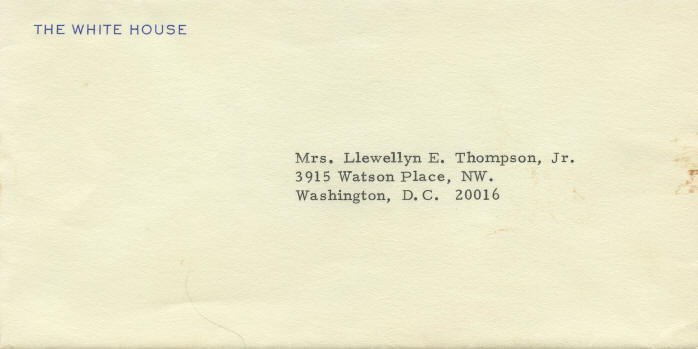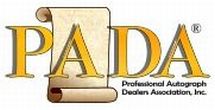

1403319
Richard M. Nixon
From the Estate of Llewellyn E. Thompson,
United States Ambassador to the Soviet Union
With an extremely rare handwritten note on White House stationery,
Nixon sends personal condolences to Ambassador Thompsonʼs widow
Richard Milhous Nixon, 1913–1994. 37th President of the United States, 1969–1974. Extremely rare Typed Letter Signed, RN, with handwritten postscript, one page, 7" x 10½", on blind-embossed stationery of The White House, Washington, [D.C.], February 9, 1972. With original envelope.
Nixonʼs available holograph material as President is virtually nonexistent. Our search of auction records found only two handwritten White House letters and one other with a handwritten postscript that have sold at auction in the last 39 years.
In this letter, Nixon adds an extremely rare handwritten note to his formal typewritten message while sending personal condolences to Jane Thompson, the widow of Ambassador Llewellyn Thompson, who had died on February 6. In full: “Our thoughts are with you, and our hearts go out to you in your grief at your husbandʼs death. Tommy was one of those remarkable statesmen whose wisdom was valued by many Presidents, whose perseverance was admired by all who worked with him and whose dedication to duty will remain an inspiration to his fellow citizens for a long time to come. / I am deeply grateful for the generous manner in which he shared his experience and talent with me and with the members of my Administration, and for the important ways in which he helped to advance our goals of a just and lasting peace. I hope that at this time you may be comforted by your pride in his enduring achievements. That pride is felt by countless fellow Americans. / Pat and I send you and your family our deepest sympathy and prayers." In the holograph postscript, he writes: “I felt especially close to Tommy and to you because of our meetings in Vienna and Moscow. Pat and I often say – ʻThere are no more gracious hosts in the world than the Thompsons.'"
That Nixon added a handwritten note—after all, he virtually always signed presidential letters with only his initials—shows the importance that he attached to his long relationship with Ambassador Thompson.
Nixon indeed knew Thompson well. Thompson, who was born in 1904, was a career American diplomat who served at a critical time in history as the United States Ambassador to the Soviet Union under Presidents Dwight D. Eisenhower, John F. Kennedy, and Lyndon B Johnson. He joined the Foreign Service in 1928, and during his long and distinguished career he served as the United States Ambassador to Austria from 1955 to 1957 before Eisenhower appointed him Ambassador to the Soviet Union in 1957. Kennedy reappointed him to Moscow in 1961. He resigned in 1962, but Johnson reappointed him in 1967, and he served until 1969. He also held the posts of Career Ambassador and Ambassador At Large. He was part of the Executive Committee to the National Security Council, or ExComm, which advised Kennedy during the Cuban Missile Crisis in October 1962, and he was present at Johnson's summit with Soviet Premier Alexei Kosygin at Glassboro, New Jersey, in June 1967.
In 1956, Thompson, then the Ambassador to Austria, assisted then-Vice President Nixon on his 1956 inspection trip to survey the refugee situation when 180,000 Hungarians fled to Austria as the Soviet Union militarily crushed the Hungarian Revolution. Three years later, Thompson accompanied Vice President Nixon at the opening of the American National Exhibition in Moscow, part of a cultural exchange between the United States and the Soviet Union. It was at that exhibition that Nixon and Soviet Premier Nikita Khrushchev engaged in a series of impromptu hard-hitting ideological debates that covered the range of Soviet-American relations—the threat of atomic war, diplomacy by ultimatum, and economic progress—including a notable exchange, known as the “Kitchen Debate,” in the Betty Crocker kitchen of a modern American home that was on display. Thompson again helped Nixon when, as a private citizen, Nixon visited the Soviet Union in March 1967 in the first of four foreign study trips that he used as the springboard to launch his campaign for the 1968 Republican presidential nomination. After Nixon became President, Thompson came out of retirement to advise him on the Strategic Arms Limitation Treaty (SALT) negotiations with the Soviet Union and to serve as a member of the United States delegation to the SALT talks from 1969 until his death in 1972.
Nixon has signed this letter with his initials, as he typically did as President, and has written the postscript in black fountain pen. The letter has two normal horizontal folds, which do not affect either Nixon's signature or the holograph postscript, and shows slight handling. The original envelope was not mailed and therefore presumably was hand delivered from the White House. It has a paper clip rust stain at the right end, more pronounced on the back, and a pencil notation on the back. The envelope is in fine condition, and the letter is very fine.
Nixon's holograph material is rare of itself, and as President it is extremely rare. Collectors of Nixonʼs letters therefore should be careful not to let this letter pass. It belongs in the finest of Nixon or presidential collections.
Provenance: This letter comes directly from the Thompson estate. It has never been offered on the autograph market before.
Unframed.
_____________
This item has been sold, but
click here to see other
Presidents and First Ladies items
that we are offering.



